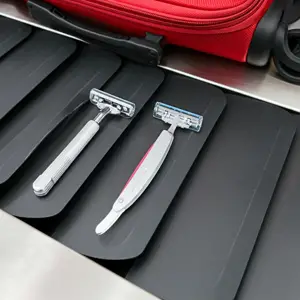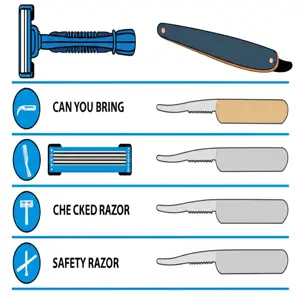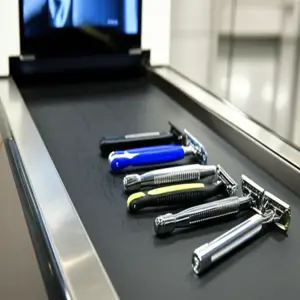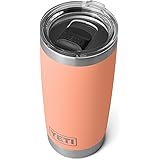Navigating airport security can be a stressful experience, especially when you’re unsure about what items you can and cannot bring on a plane. One common question that plagues travelers is, “Can you bring a razor on a plane?” The answer, like many things related to air travel, isn’t always a simple yes or no. The Transportation Security Administration (TSA) has specific rules and regulations regarding razors, and understanding these rules is crucial for a smooth and hassle-free journey.
This comprehensive guide will break down the TSA’s razor rules for 2024, covering everything from disposable razors to electric shavers, and providing you with the knowledge you need to pack with confidence.
In this guide, we will cover:
- The TSA’s official stance on different types of razors.
- Where you should pack your razor (carry-on vs. checked baggage).
- Tips for traveling with razors to ensure compliance with TSA guidelines.
- Frequently asked questions about bringing razors on a plane.
- Current trends and statistics related to prohibited items at airport security.
Understanding the TSA’s Razor Policy: A 2024 Overview
The TSA’s primary goal is to ensure the safety and security of air travelers. To achieve this, they have established clear guidelines about what items are permitted in carry-on and checked baggage. The rules regarding razors are based on the potential risk they pose.
Items that could be used as weapons are generally restricted from carry-on baggage but may be allowed in checked baggage, depending on the specific item. Let’s delve into the specifics of how these rules apply to different types of razors.

Different Types of Razors and Their TSA Status
Not all razors are created equal, and the TSA treats them differently. Here’s a breakdown of the most common types of razors and their current status under TSA regulations:
- Disposable Razors: These are generally the most straightforward.
- Cartridge Razors: Similar to disposable razors, but with replaceable cartridges.
- Safety Razors: These razors have a single, double-edged blade that is inserted into a handle.
- Electric Razors: Battery-powered or rechargeable shavers.
- Straight Razors: These razors have a long, exposed blade that folds into a handle.
Disposable Razors: Your Easiest Option
Disposable razors, like Bic or Gillette disposable razors, are generally allowed in both carry-on and checked baggage. Because the blade is permanently encased in plastic, they pose a very low security risk. This makes them the easiest and most convenient option for travelers who need to shave during their trip. There are hardly ever issues when bringing these on planes.

TSA razor rules
TSA Status: Allowed in carry-on and checked baggage.
Cartridge Razors: Simple and Usually Allowed
Cartridge razors, such as Gillette Mach3 or Venus razors, are also generally allowed in both carry-on and checked baggage. Like disposable razors, the blade is contained within a cartridge, reducing the risk of it being used as a weapon. As long as the cartridge is attached to the handle, you should have no problems bringing it on a plane.
TSA Status: Allowed in carry-on and checked baggage (cartridge attached to the handle).
Safety Razors: Handle with (Extra) Care
Safety razors are where things get a bit more complicated. The key distinction is whether the blade is attached or detached. The TSA’s official stance is that safety razors with *removable* blades are not allowed in carry-on baggage. However, the handle itself can be brought on the plane. You would need to purchase blades at your destination or pack them in your checked baggage.
TSA Status:
- Handle: Allowed in carry-on and checked baggage.
- Loose Blades: NOT allowed in carry-on baggage; allowed in checked baggage (must be safely packed).
Important Note: If you choose to pack safety razor blades in your checked baggage, it’s crucial to package them securely. Wrap them in paper or cloth, and place them in a sturdy container to prevent them from shifting during transit and potentially causing injury to baggage handlers or TSA personnel. A small, hard case designed for razor blades is ideal.
Electric Razors: Travel Friendly and TSA Approved
Electric razors, whether battery-powered or rechargeable, are generally allowed in both carry-on and checked baggage. There are usually no issues at all bringing these razors.
TSA Status: Allowed in carry-on and checked baggage.
Note: If your electric razor is battery-powered, it’s always a good idea to check the specific regulations regarding lithium batteries, especially if it’s a rechargeable model. While electric razors themselves are permitted, lithium batteries sometimes have restrictions based on their watt-hour rating. The TSA website (www.tsa.gov) has detailed information about lithium battery regulations. Also, keep in mind if you have a model that requires charging, you’ll need access to an outlet or a portable charger during your travels.
Straight Razors: The Riskiest Razor for Air Travel
Straight razors pose the biggest challenge when flying. Due to their long, exposed blade, they are generally prohibited in carry-on baggage. The TSA considers them a potential weapon, and they are almost always confiscated if found in a carry-on.
TSA Status: NOT allowed in carry-on baggage; allowed in checked baggage (must be safely sheathed or wrapped).
Safety First: If you need to travel with a straight razor, it is essential to pack it properly in your checked baggage. Wrap the blade securely in a thick cloth or leather sheath to prevent accidental cuts. Consider placing it in a hard case for added protection. The goal is to ensure that the blade cannot easily pierce through the packaging and pose a risk to baggage handlers or TSA personnel.
Razor Packing Guide: Carry-On vs. Checked Baggage
Now that you understand the TSA’s regulations for each type of razor, let’s break down where you should pack them: in your carry-on bag or your checked baggage.
Carry-On Baggage: What’s Allowed and What’s Not
Carry-on baggage is subject to stricter regulations because these items are accessible during the flight. Here’s a quick reference guide for razors in carry-on baggage:
- Disposable Razors: Allowed.
- Cartridge Razors: Allowed (cartridge attached to handle).
- Safety Razors: Handle allowed, blades NOT allowed.
- Electric Razors: Allowed.
- Straight Razors: NOT allowed.
Pro Tip: To avoid any confusion or delays at security, consider packing your razors in a clear, resealable plastic bag. This makes it easy for TSA officers to inspect them if necessary.
Checked Baggage: More Lenient, But Still Requires Caution
Checked baggage is less restricted than carry-on baggage, but it’s still important to pack your razors safely and securely to prevent damage or injury. Here’s a guide for razors in checked baggage:
- Disposable Razors: Allowed.
- Cartridge Razors: Allowed.
- Safety Razors: Handle and blades allowed (blades must be safely wrapped).
- Electric Razors: Allowed.
- Straight Razors: Allowed (must be safely sheathed or wrapped).
Packaging Matters: Regardless of the type of razor you’re packing in your checked baggage, take the time to wrap it securely. Use bubble wrap, cloth, or a dedicated razor case to prevent it from being damaged during transit. This also protects other items in your bag from potential damage.
Real-World Examples and Case Studies
To illustrate how these rules play out in real life, let’s look at a few examples:
- Scenario 1: Sarah is traveling for a business trip and prefers to use her safety razor. She packs the handle in her carry-on bag to shave at the hotel. She purchases new blades at her destination to avoid any issues with TSA. This is a perfectly acceptable and compliant approach.
- Scenario 2: John is a barber and needs to travel with his straight razor for a competition. He carefully sheathes the blade in a leather case, wraps it in bubble wrap, and places it in a hard-sided container within his checked baggage. This ensures that the razor is safely transported and minimizes the risk of damage or injury.
- Scenario 3: Maria attempts to bring a safety razor with loose blades in her carry-on bag. TSA officers discover the blades during the security screening and confiscate them. Maria is allowed to keep the handle but must purchase new blades at her destination. This highlights the importance of knowing and following the TSA’s regulations.
TSA Website and Mobile App: Your Go-To Resources
The TSA’s website (www.tsa.gov) and mobile app (“MyTSA”) are invaluable resources for travelers. These platforms provide up-to-date information on prohibited items, security procedures, and travel tips. You can even use the “Can I Bring?” feature on the website or app to search for specific items and get instant answers on whether they are allowed in carry-on or checked baggage. It is worth noting that while information can be easily found on their website, sometimes the agents themselves may have differing opinions. In those cases, it’s best to err on the side of caution.
Pro Tip: Before you pack your bags, take a few minutes to check the TSA website or app for the latest regulations. Security policies can change, so it’s always best to be informed.
Tips for a Smooth Security Screening Experience
Even if you’ve packed your razors correctly, there are steps you can take to further streamline your security screening experience:
- Be Prepared: Have your boarding pass and ID ready.
- Remove Electronics: Take out laptops and other large electronic devices from your carry-on bag and place them in a separate bin.
- Liquids Bag: Ensure that all liquids in your carry-on bag are in containers that are 3.4 ounces (100 milliliters) or less and placed in a clear, resealable plastic bag.
- Declare Items: If you’re unsure about an item, declare it to a TSA officer. It’s better to ask than to risk having an item confiscated.
- Be Patient and Cooperative: Security screenings can take time, so be patient and cooperate with TSA officers. They are there to ensure the safety of all travelers.
What Happens If a Razor is Confiscated?
If a TSA officer finds a prohibited razor in your carry-on baggage, they will typically confiscate it. You may have the option to place the item in your checked baggage (if you haven’t already checked your bags), mail it to yourself, or surrender it to the TSA. Confiscated items are not returned. To avoid this situation, always check the TSA’s regulations before you pack.
The 3-1-1 Liquids Rule and Razors
The TSA’s 3-1-1 liquids rule applies to liquids, gels, and aerosols in carry-on baggage. While this rule doesn’t directly affect razors themselves (unless you’re carrying shaving cream or gel), it’s important to be aware of it to avoid delays at security. Make sure any shaving cream or gel you bring in your carry-on bag adheres to the 3-1-1 rule: containers must be 3.4 ounces (100 milliliters) or less and placed in a single, clear, resealable plastic bag.
Traveling Internationally: Be Aware of Varying Regulations
While the TSA’s regulations apply to flights within the United States, other countries may have different rules regarding razors and other items. Before traveling internationally, it’s essential to check the security regulations of the countries you’re visiting and any airlines you’re flying with. Some countries may have stricter rules than the TSA, while others may be more lenient. It’s always best to be prepared and avoid any surprises at airport security.
Current Trends and Statistics Related to Prohibited Items
The TSA regularly publishes statistics on prohibited items discovered at airport security checkpoints. While specific data on razors alone may not be available, the overall trend is that prohibited items continue to be a significant issue. In 2023, the TSA screened over 858 million passengers and discovered a large number of prohibited items, including firearms, knives, and other potential weapons. These statistics underscore the importance of knowing and following the TSA’s regulations to ensure a safe and efficient security screening process. According to a recent TSA report, the most commonly confiscated items include:
- Firearms
- Knives (including some razors)
- Liquids exceeding the 3.4-ounce limit
- Tools
These findings highlight the need for travelers to be more aware of what they are packing and how it complies with security regulations. As of the most recent data available (early 2024), confiscation rates are relatively stable compared to previous years, indicating that while awareness campaigns are helping, there is still room for improvement.
The Future of Airport Security and Razor Regulations
Airport security technology is constantly evolving, and it’s possible that future advancements could impact the regulations regarding razors. For example, new screening technologies could be developed that can more accurately assess the risk posed by different types of razors, potentially leading to changes in what is allowed in carry-on baggage. Additionally, increased emphasis on passenger education and awareness campaigns could help to reduce the number of prohibited items discovered at security checkpoints. One trend gaining traction is the use of advanced imaging technology, which can provide more detailed scans of baggage and passengers. This technology could potentially allow TSA officers to more easily identify and assess the risk posed by razors and other potentially dangerous items.
Alternatives to Bringing Razors
If you’re concerned about the hassle of bringing razors on a plane, or if you’re traveling light and want to minimize your baggage, there are several alternatives to consider:

airplane razor
- Purchase Razors at Your Destination: This is the simplest option. You can buy disposable razors or cartridges at most drugstores or supermarkets.
- Use a Travel-Sized Electric Razor: These compact shavers are designed specifically for travel and are generally allowed in both carry-on and checked baggage.
- Consider Laser Hair Removal: For a more permanent solution, consider laser hair removal treatments before your trip.
Table: TSA Razor Rules Summary (2024)
| Razor Type | Carry-On Baggage | Checked Baggage | Notes |
|---|---|---|---|
| Disposable Razors | Allowed | Allowed | Simplest option. |
| Cartridge Razors | Allowed | Allowed | Cartridge must be attached to handle. |
| Safety Razors | Handle Allowed, Blades NOT Allowed | Handle and Blades Allowed | Blades must be safely wrapped and contained. |
| Electric Razors | Allowed | Allowed | Check lithium battery regulations if applicable. |
| Straight Razors | NOT Allowed | Allowed | Must be safely sheathed or wrapped. |
Common Misconceptions About Razors and Air Travel
There are several common misconceptions about razors and air travel that can lead to confusion and frustration at airport security. Here are a few of the most common myths debunked:
- Myth: All razors are prohibited in carry-on baggage. Fact: Disposable razors, cartridge razors, and electric razors are generally allowed in carry-on baggage.
- Myth: You can sneak a straight razor through security if you hide it well enough. Fact: TSA officers are highly trained to detect prohibited items, and attempting to conceal a straight razor is likely to result in confiscation and potential penalties.
- Myth: The TSA doesn’t care about small items like razor blades. Fact: The TSA takes all potential security threats seriously, regardless of size. Razor blades, even small ones, can be used as weapons and are therefore prohibited in carry-on baggage.
Understanding the facts and dispelling these myths can help you pack more effectively and avoid unnecessary delays at airport security.

travel razor allowed
Seeking Clarification from TSA: Social Media and Contact Information
If you still have questions about the TSA’s razor policy or any other travel-related inquiries, you can reach out to the TSA directly through their website or social media channels. The TSA’s Twitter account (@AskTSA) is a great resource for getting quick answers to your questions. You can also contact the TSA Contact Center by phone or email. Remember to provide as much detail as possible about your specific situation to get the most accurate and helpful response.
Frequently Asked Questions (FAQ)
Here are some of the most frequently asked questions about bringing razors on a plane:
Can I bring a disposable razor in my carry-on bag?
Yes, disposable razors are allowed in carry-on bags.
Are cartridge razors allowed in carry-on luggage?
Yes, cartridge razors are generally permitted in carry-on luggage, as long as the cartridge is attached to the handle.
Can I pack safety razor blades in my checked bag?
Yes, you can pack safety razor blades in your checked bag, but they must be safely wrapped and contained to prevent injury.
Are electric razors allowed on planes?
Yes, electric razors are allowed in both carry-on and checked baggage. Be mindful of the battery requirements if it is battery-powered.
What if the TSA agent has a different interpretation of the rules?
While the TSA has established guidelines, individual TSA agents have the final say on what is allowed through security. If an agent interprets the rules differently, it’s best to comply with their instructions. If you believe the agent is incorrect, you can politely ask to speak to a supervisor.
Can I bring shaving cream in my carry-on?
Yes, but it must adhere to the 3-1-1 liquids rule: containers must be 3.4 ounces (100 milliliters) or less and placed in a single, clear, resealable plastic bag.
What happens if I accidentally pack a prohibited razor in my carry-on?
The TSA officer will likely confiscate the razor. You may have the option to place it in your checked baggage (if you haven’t already checked your bags), mail it to yourself, or surrender it to the TSA.
Are there any exceptions to the razor rules for medical reasons?
While there are no specific exceptions for razors, if you have a medical condition that requires you to use a specific type of razor, you can contact the TSA Cares helpline for assistance. Be prepared to provide documentation from your doctor.
Can I bring a razor on an international flight?
Yes, but be aware that other countries may have different regulations regarding razors and other items. Check the security regulations of the countries you’re visiting and any airlines you’re flying with.
Where can I find the most up-to-date information on TSA razor rules?
The TSA’s website (www.tsa.gov) and mobile app (“MyTSA”) are the best resources for the most up-to-date information on TSA razor rules and other security procedures.
Conclusion: Final Thoughts on Traveling with Razors in 2024
Traveling with razors doesn’t have to be a source of anxiety. By understanding the TSA’s regulations, packing your razors correctly, and staying informed about any changes to security policies, you can ensure a smooth and stress-free travel experience. The key takeaway is that disposable razors, cartridge razors, and electric razors are generally permitted in carry-on baggage, while safety razors with removable blades and straight razors are typically restricted to checked baggage. Always prioritize safety and security by wrapping blades securely and following the TSA’s guidelines. Remember, the TSA’s primary goal is to protect travelers, and by cooperating with their procedures, you contribute to a safer and more efficient air travel system.
Before you head to the airport, take a few minutes to review the TSA’s website or app, and double-check that you’ve packed your razors in accordance with their regulations. A little preparation can go a long way in preventing delays and ensuring a pleasant journey. Safe travels!
Hopefully, this has cleared up any confusion you may have had on whether you can bring a razor on a plane. By knowing the rules, you can relax and enjoy your travels. Be sure to also check out our article on traveling with electronics, and can you bring pen on a plane!






